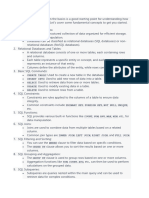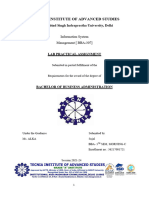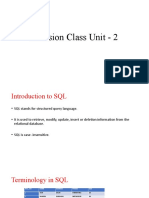Certainly, let's break down the topics from the introduction to SQL section you provided:
1. Characteristics of SQL:
● SQL stands for Structured Query Language. It's the standard language used for
managing relational databases.
● SQL is a declarative language - you specify what you want, not how to do it. This makes
it user-friendly and powerful.
● SQL is a high-level language - it abstracts away the complexities of database
operations, making it easier to learn and use.
2. Advantages of SQL:
● Standardization: SQL is an ANSI and ISO standard, ensuring compatibility across
different database systems.
● Ease of Use: SQL is relatively easy to learn and use, especially for basic queries and
data manipulation.
● Powerful Query Capabilities: SQL allows for complex queries to retrieve and manipulate
data.
● Data Integrity: SQL provides features like constraints and triggers to maintain data
integrity.
3. SQL Data Types and Literals:
● Data types: SQL defines various data types to represent different kinds of data, such as:
○ CHAR, VARCHAR (fixed and variable-length character strings)
○ INT, SMALLINT, BIGINT (integer numbers)
○ FLOAT, DOUBLE (floating-point numbers)
○ DATE, TIME, TIMESTAMP (date and time values)
○ BOOLEAN (logical values: TRUE, FALSE)
● Literals: Literals are values directly written in SQL statements, like:
○ 'Hello World' (string literal)
○ 123 (integer literal)
○ 3.14 (floating-point literal)
○ '2023-11-25' (date literal)
4. Types of SQL Commands:
● DDL (Data Definition Language):
○ CREATE TABLE: Creates a new table.
○ ALTER TABLE: Modifies an existing table (add, drop columns, change data types).
○ DROP TABLE: Deletes a table.
● DML (Data Manipulation Language):
○ INSERT: Inserts rows into a table.
○ UPDATE: Updates existing rows in a table.
○ DELETE: Deletes rows from a table.
○ SELECT: Retrieves data from one or more tables.
● DCL (Data Control Language):
○ GRANT: Grants privileges to users.
○ REVOKE: Revokes privileges from users.
5. SQL Operators:
● Arithmetic Operators: +, -, *, / (for numerical operations)
● Comparison Operators: =, !=, >, <, >=, <= (for comparing values)
● Logical Operators: AND, OR, NOT (for combining conditions)
● String Operators: LIKE, || (for string manipulation)
6. Tables, Views, and Indexes:
� ● Tables: The fundamental data structures in a relational database, storing rows and
columns.
● Views: Virtual tables based on the result-set of an SQL statement. They provide a
different perspective on the underlying data.
● Indexes: Data structures that improve the performance of data retrieval by creating a
sorted list of values and their locations.
7. Insert, Update, and Delete Operations:
● INSERT: Adds new rows to a table.
● UPDATE: Modifies existing rows in a table.
● DELETE: Removes rows from a table.
8. Queries and Subqueries:
● Queries: SQL statements that retrieve data from the database.
● Subqueries: Queries nested within other queries.
9. Aggregate Functions:
● COUNT: Counts the number of rows.
● SUM: Calculates the sum of values.
● AVG: Calculates the average of values.
● MIN: Finds the minimum value.
● MAX: Finds the maximum value.
10. Joins, Unions, Intersections, and Minus:
● Joins: Combine rows from two or more tables based on a related column.
● Union: Combines the result sets of two or more SELECT statements, eliminating
duplicates.
● Intersection: Returns the rows that are present in both result sets of two SELECT
statements.
● Minus: Returns the rows that are present in the first result set but not in the second.
11. Cursors:
● Allow you to process rows from a result set one at a time.
12. Triggers:
● Procedures that automatically execute in response to specific events (e.g., INSERT,
UPDATE, DELETE).
Let me know if you would like a more detailed explanation of any of these topics!






















































































